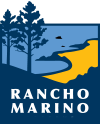The establishment of Mission San Antonio de Padua in 1771 and of Mission San Miguel in 1797 led to both a change in land use for the coastal terraces and an increased European presence. Cambria was once part of the lands of Mission San Miguel. After Mexico declared its independence from Spain in 1821, the Missions were secularized and the lands were given to prominent individuals through the land grant system. In 1841, the 13,000 acre Rancho Santa Rosa was granted to Don Julian Estrada.
In the mid-1800s Cambria area industries included cinnabar mining and sales, lumbering, dairying, beef-cattle ranching, whaling, and grain and orchard farming. On the Reserve, a dairy farm and hay dry farming was conducted on the coastal terrace from the mid-1800s until 1940. In 1940 the new owner, Hiram Sibley, recognized the value of the land for beef-cattle ranching. In the 1950s dry farming of hay ended and large areas of the coastal terrace were planted with Harding grass (Phalaris aquatica).
Living on the ocean cliff of the Sibley Ranch (Reserve), the late George Lum [George Wong] was one of the last remaining seaweed (Ulva and Porphyra spp.) farmers along the north coast of San Luis Obispo County. George and his family lived on the Reserve lands approximately 35 years, leaving in the late 1960s. Seaweed farming involved the simple but laborious task of gathering edible seaweed from the rocks where it grows, drying it in the sun, and packing it for shipment to markets in San Francisco and China. The intertidal substrate was prepared for the subsequent crop by burning inedible seaweed and their spores in the winter. Otherwise, inedible seaweed species would take over, and prevent preferred seaweed species from growing back.
In the 1980’s the ranch was purchased by the current owners and in 2001 the Rancho Marino Reserve became part of the University of California Natural Reserve System with a land use agreement.
